



Living in the mountains mostly in places that are not easily accessible the people of the district have been able to preserve their culture, folklore, folksongs and folkdances, the last, a distinctive feature of the district, being seasonal, traditional and religious, some of the better known being described below.....Read More
Temples in Joshimath
Adibadri Temple
Adbadri ,also known in revenue records as Helisera, is set in beautiful surroundings and the road from Lohba to Adbadri passes through scenic terrain. Just above Adbadri is the small Lake of Benital. At Adbadri are the remains of Sixteen temples similar to those found at dwarahat ( in district Almora) and the one dedicated to Badrinarayan is still used for worship as are the others but to a lesser degree. The local people have a superstitious belief that in a few year the road from Joshimath to Badrinath will be closed by the meeting of the hill near the temple that stand opposite each other and that then this temple will become a place for pilgrimage. There are..... Read More
Narasingha Temple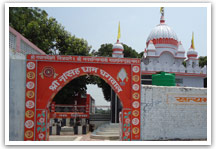
Narsingh is one of the avatars of lord Vishnu. When the Badrinath Temple is closed in winter, devotees throng to worship at the Narsingh Temple at Joshimath. The characteristic feature of the deity is that its left wrist is very thin and is getting thinner by the day. A legend goes about the deity's wrist is that of being a sign that the day the wrist separates from the forearm, the route to Badrinath would get closed permanently by a major ..... Read More
Badrinath Temple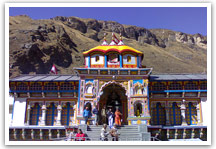
Badrinath Temple is considered the holiest of the Char Dham Hindu pilgrimage in Uttarakhand. It is delicately placed between the mountains of Nar and Narayan with River Alaknanda flowing peacefully beside it. It is known as Badrinath since the entire region is covered with Badri trees (Indian Jujube).Also known as Vishal Badri, this temple located at the height of 3,133 mts. is the largest Himalayas and most popular of Vishnu pilgrimages among the five Badries. The original temple here is believed to be built by King Pururava and the icon of the lord carved by Vishwakarma, the creator of the gods. The idol was recovered by Adi Shankaracharya..... Read More
Bhavishya Badri Temple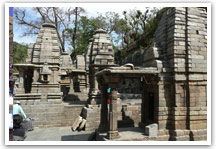
The Bhavishya Badri is located at 2,744 mts. amidst the thick forests surrounding Tapovan. According to a divination, it is here that all devotees will throng once Badrinath is no more. While there can be no conceivable reason why this should happen, scientists agree that Joshimath, the entry point into the area before the final, most strenuous climb, is sited on an ancient landslide and has been sinking, and with a barrage coming up close by, may actually see the fulfillment of the divine prophecy. But whatever happens, Bhavishya Badri is popular even now. Enshrined here is the lion-headed image of Narsingh. Visitors pass the serene..... Read More
Hemkund Sahib Temple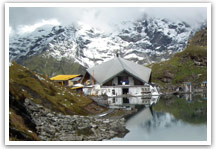
Hemkund Sahib is the holiest shrines of Sikhs in India. It is located at high altitudes amidst snow covered lofty peaks of Himalayas in the state of Uttarakhand. This panoramic site is flanked by a serene Lake called Hemkund. On the banks of this lake is situated a Gurudwara, dedicated to the tenth Guru of Sikhs, Guru Gobind Singh. The natural beauty of the place is simply awe-inspiring as the glacial lake is surrounded by seven soaring peaks, giving a boost to the travel and tourism industry. Regarding the origin of the place, it is believed that Sikh Guru, Guru Gobind Singh performed penance her in his previous birth and united with the Almighty.... Read More
Kalpeshwar Temple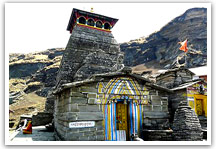
Kalpeshwar is situated at an altitude of 2,134 mts above sea level near Urgam Valley in Chamoli district of Uttarakhand state. Kalpeshwar can be reached by an easy trek of 11 km starting from Helang. The captivating Urgam valley can be reached after a trek of 9 kms from Helang. There are two routes from Urgam Valley one ending up at Kalpeshwar and other going to Panar and Rudranath via Dumak. Kalpeshwar is the last temple in the list of Panch Kedar pilgrimage circuit. It is the only temple of the sacred Panch Kedar that remains opened throughout the year. Lord Shiva is worshipped in the form of matted hair at Kalpeshwar. The trail..... Read More
Virdha Badri Temple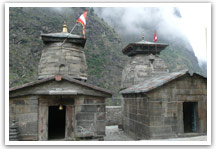
Sri Vridha badri has great importance itself, Before Badrinath was designated one of the four Char Dhams of Hindu worship by Adi Shankaracharya, the idol of Badrinah carved by divine Vishwakarma was enshrined and worshipped here. It is Seven kilometres from Joshimath, at Animath, and in the direction of Pipalkoti before Helang. It is said that when mankind entered the age of Kali, Vishnu chose to remove himself from the temple. Interestingly the image was found by Adi Shankaracharya at NaradKund, and restored, through part of it remains damaged. This, the first Badri, is located at the height of 1,380 mts. at Animath. While Badrinath..... Read More
Yogdhyan Badri Temple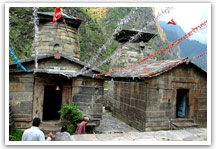
The Yogdhan Badri is located at Pandukeshwar in altitude of 1920m, The Yogdhan Badri named after the Pandva's King. It is said that the Pandavas, victorious after their battle against the Kauravas, but emotionally scarred, came to the Himalayas. And it was here that they handed over their capital, Hastinapur, to Raja Parikshit and took up penance before seeking out the highway to heaven. The importance of the Badri is immense and the sanctum has an image of the lord in a meditative posture. It is also said that The Yogdhan Badri named after Pandu, who meditated at this place, 23 km from Sadrinath to lift the curses of a sage, and was..... Read More
Adibadri Temple

Adbadri ,also known in revenue records as Helisera, is set in beautiful surroundings and the road from Lohba to Adbadri passes through scenic terrain. Just above Adbadri is the small Lake of Benital. At Adbadri are the remains of Sixteen temples similar to those found at dwarahat ( in district Almora) and the one dedicated to Badrinarayan is still used for worship as are the others but to a lesser degree. The local people have a superstitious belief that in a few year the road from Joshimath to Badrinath will be closed by the meeting of the hill near the temple that stand opposite each other and that then this temple will become a place for pilgrimage. There are..... Read More
Narasingha Temple

Narsingh is one of the avatars of lord Vishnu. When the Badrinath Temple is closed in winter, devotees throng to worship at the Narsingh Temple at Joshimath. The characteristic feature of the deity is that its left wrist is very thin and is getting thinner by the day. A legend goes about the deity's wrist is that of being a sign that the day the wrist separates from the forearm, the route to Badrinath would get closed permanently by a major ..... Read More
Badrinath Temple

Badrinath Temple is considered the holiest of the Char Dham Hindu pilgrimage in Uttarakhand. It is delicately placed between the mountains of Nar and Narayan with River Alaknanda flowing peacefully beside it. It is known as Badrinath since the entire region is covered with Badri trees (Indian Jujube).Also known as Vishal Badri, this temple located at the height of 3,133 mts. is the largest Himalayas and most popular of Vishnu pilgrimages among the five Badries. The original temple here is believed to be built by King Pururava and the icon of the lord carved by Vishwakarma, the creator of the gods. The idol was recovered by Adi Shankaracharya..... Read More
Bhavishya Badri Temple

The Bhavishya Badri is located at 2,744 mts. amidst the thick forests surrounding Tapovan. According to a divination, it is here that all devotees will throng once Badrinath is no more. While there can be no conceivable reason why this should happen, scientists agree that Joshimath, the entry point into the area before the final, most strenuous climb, is sited on an ancient landslide and has been sinking, and with a barrage coming up close by, may actually see the fulfillment of the divine prophecy. But whatever happens, Bhavishya Badri is popular even now. Enshrined here is the lion-headed image of Narsingh. Visitors pass the serene..... Read More
Hemkund Sahib Temple

Hemkund Sahib is the holiest shrines of Sikhs in India. It is located at high altitudes amidst snow covered lofty peaks of Himalayas in the state of Uttarakhand. This panoramic site is flanked by a serene Lake called Hemkund. On the banks of this lake is situated a Gurudwara, dedicated to the tenth Guru of Sikhs, Guru Gobind Singh. The natural beauty of the place is simply awe-inspiring as the glacial lake is surrounded by seven soaring peaks, giving a boost to the travel and tourism industry. Regarding the origin of the place, it is believed that Sikh Guru, Guru Gobind Singh performed penance her in his previous birth and united with the Almighty.... Read More
Kalpeshwar Temple

Kalpeshwar is situated at an altitude of 2,134 mts above sea level near Urgam Valley in Chamoli district of Uttarakhand state. Kalpeshwar can be reached by an easy trek of 11 km starting from Helang. The captivating Urgam valley can be reached after a trek of 9 kms from Helang. There are two routes from Urgam Valley one ending up at Kalpeshwar and other going to Panar and Rudranath via Dumak. Kalpeshwar is the last temple in the list of Panch Kedar pilgrimage circuit. It is the only temple of the sacred Panch Kedar that remains opened throughout the year. Lord Shiva is worshipped in the form of matted hair at Kalpeshwar. The trail..... Read More
Virdha Badri Temple

Sri Vridha badri has great importance itself, Before Badrinath was designated one of the four Char Dhams of Hindu worship by Adi Shankaracharya, the idol of Badrinah carved by divine Vishwakarma was enshrined and worshipped here. It is Seven kilometres from Joshimath, at Animath, and in the direction of Pipalkoti before Helang. It is said that when mankind entered the age of Kali, Vishnu chose to remove himself from the temple. Interestingly the image was found by Adi Shankaracharya at NaradKund, and restored, through part of it remains damaged. This, the first Badri, is located at the height of 1,380 mts. at Animath. While Badrinath..... Read More
Yogdhyan Badri Temple

The Yogdhan Badri is located at Pandukeshwar in altitude of 1920m, The Yogdhan Badri named after the Pandva's King. It is said that the Pandavas, victorious after their battle against the Kauravas, but emotionally scarred, came to the Himalayas. And it was here that they handed over their capital, Hastinapur, to Raja Parikshit and took up penance before seeking out the highway to heaven. The importance of the Badri is immense and the sanctum has an image of the lord in a meditative posture. It is also said that The Yogdhan Badri named after Pandu, who meditated at this place, 23 km from Sadrinath to lift the curses of a sage, and was..... Read More
Home | Joshimath | Tourism | Hotels | Culture | Education | Villages | Places Near Joshimath | Photo Gallery | Enquriy | Contact Us
Events | Trkking in Joshimath | Joshimath Classified | Skiing at Auli | Yoaga in Joshimath | Pilgrimage Tours
National Parks Tours | Safari Tours | Bird Watching | Corporate Tours
Cuisine | Fairs & Festivals | Local Products
Events | Trkking in Joshimath | Joshimath Classified | Skiing at Auli | Yoaga in Joshimath | Pilgrimage Tours
National Parks Tours | Safari Tours | Bird Watching | Corporate Tours
Cuisine | Fairs & Festivals | Local Products
Copyright © 2023 - All Rights Reserved : joshimath.in Design by : Joshimath Portal Team

